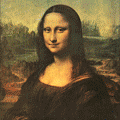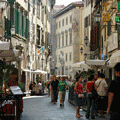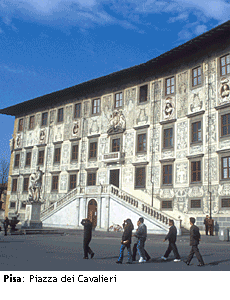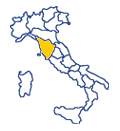Historical buildings and monuments
The Camposanto Monumentale was founded in 1277 and completed in 1464. This cemetery is a cloister of vast galleries around the central area, which according to legend contains the "holy soil” from Palestine brought here by Pisan crusaders. Towards the middle of the fifteenth century, the Camposanto contained one of the largest painting series of its time: the walls were entirely covered in frescos, however they were destroyed following ally bombings during the Second World War.
The Jewish Cemetery is located within Piazza dei Miracoli and dates back to 1648. It is one of the oldest Hebrew cemeteries in Europe. The inscriptions on the tombs are not only in Hebrew, but also in Italian, Spanish, Portuguese, French, German and Czech. The cemetery presents an extraordinary historical artistic repertoire: from the parallelepiped burial mounds of Hebrew tradition dating from 17th to 18th centuries to the Liberty styles dating from the 19th and 20th centuries.
The beautiful Piazza dei Cavalieri was the political center of the Pisan Republic. During the 16th century it was radically transformed by Giorgio Vasari on the wishes of Cosimo I De Medici and became the seat of the new military order known as the Knights of St. Stephen.
The center of the square is dominated by a statue of Cosimo I de Medici. The square hosts the Palazzo della Carovana dei Cavalieri, whose facade is completely covered in graffiti, and today hosts the Scuola Normale Superiore. Located on the left, the Palazzo dell'Orologio, an age-old hospital of the Order of Knights of St. Stephen, whose construction incorporated two pre-existing towers. One of these was where Count Ugolino and his sons were left to die of hunger following their suspected treason, as recalled by Dante Alighieri in his Inferno. Still in the square, one can find the Church of Saint Stephen of the Knights, a building designed by Giorgio Vasari, with a splendid marble facade. The interior of the church is covered by an impressive ceiling in engraved and gold painted wood. The church also hosts trophies of flags and parts of ships taken from the Turks during sea patrols carried out by the Knights. The south side of the square hosts the monumental facade of the Palazzo del Consiglio dei Dodici. The building, designed by Vasari, was restored in 1603 and has a noble facade decorated in white marble.
The “Lungarni” Quays. For centuries these quays were the heart of the city. Until the nineteenth century they were covered with piers and docks. These were later destroyed to reinforce the banks. The “Lungarni” are presented as a succession of beautiful noble buildings, interrupted by five bridges that unite the city. Mezzo Bridge, the most central, hosts the Game of the Bridge each June. You can admire some of the remarkable buildings while walking along the river. On Lungarno Mediceo: Palazzo Schiff, Palazzo Concioni and Palazzo Toscanelli; on Lungarno Pacinotti: Palazzo Agostani Venerosi, which hosts the age-old Caffé dell’Ussero; on Lungarno Galileo Galilei: Palazzo Lanfranchi, seat of the Municipality, Palazzo da Scorno, Palazzo Pretorio and Palazzo Gambacorti, in Pisan Gothic style.
The Mural by Keith Haring Keith Haring (1958 - 1990) was a young American artist who was known worldwide for his "Subway Drawings”. Pisa’s mural, measuring 180 meters, can be found on a wall in the Sant’Antonio Convent near Piazza Vittorio Emanuele II. It is Haring’s only work to have been planned from the beginning as a permanent work and is entitled: “Tuttomondo”. The thirty characters featured in the mural move in a blend of metaphor that represents harmony and peace around the world.
Photos courtesy of APT Pisa
Go to directories of the Web Sites
|





